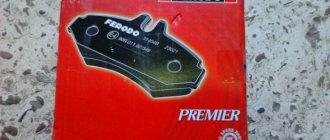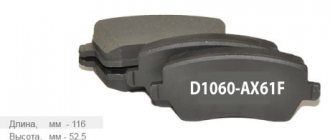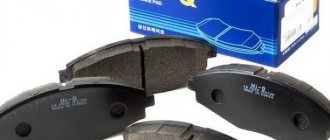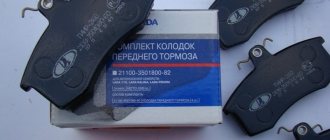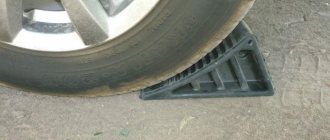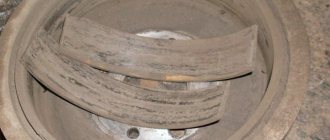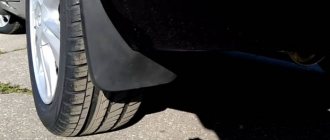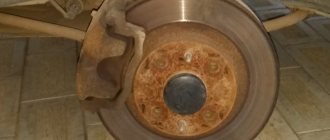Brakes are the most important mechanism of any car, which ensures the safety of its movement. Therefore, every car enthusiast is obliged to monitor their condition and from time to time replace the necessary components, including brake pads, which wear out the fastest.
The front elements on a Lada Kalina car wear out more often than the rear ones, but this is not a reason to relax, no matter what your car is: a sedan, a sports car or a station wagon, with or without ABS, the condition of the brake pads must be constantly monitored. If a thinning of components up to 1.5 mm is detected (or better before, since this is the minimum permissible limit), they should be replaced. Today we’ll talk about how to do it yourself, what tools are needed for this operation, and how to determine the need to change them.
Indirect faults
If, after checking typical and popular faults, the brake pedal still hits when braking, then problems should be looked for in other, most unexpected places. Other problems that can cause vibration or beating include wheel bearings that are heavily worn during operation. Replacing them can correct the situation. In addition, due to use, the levers on the front wheels wear out.
Vibrations can also occur as a result of unbalanced wheels.
If you have checked everything, but still cannot figure out why the pedal hits when braking, then you should check the tightness of the nuts, bolts and other fasteners. Insufficiently tightened fasteners may be the cause of backlash. At high speeds this can cause significant runout, and in such cases the brakes are usually checked.
Where can I buy?
You can buy rear drum brake pads for Lada Vesta in many stores, including ordering them online.
| Brand | vendor code | Price, rub.) |
| LYNXauto | BS-5717 | 1355 |
| FENOX | 1750 | |
| Pilenga | BSP8454 | 1340 |
| Pilenga | BS-P8454 | 2076 |
| LYNXauto | BS-3001 | 1245 |
| UBS | B11-05-007 | 1200 |
| UBS | BP11-05-007 | 2350 |
One of the pad options from FENOX
Buying brake pads is a responsible business, and therefore it is extremely important not to run into scammers selling counterfeits. Therefore, you should not chase cheapness, sacrificing quality, because this is a matter of safety on the road. It is recommended to purchase goods only from trusted suppliers.
2 more reasons why rear brakes stick
Rear brakes jam like this: the pads stick to the brake discs or drums, as a result the wheels do not rotate and the vehicle does not move.
Why do the rear brakes stick? There may be two reasons:
- The car “rested” on the handbrake for more than a month.
- The brake pads got wet when the vehicle got into a puddle, and the driver drove the car into a garage or parking lot without drying them.
You will have to be quite nervous in such circumstances. The rear brakes are jammed, there is no way to even get to the service station. You'll have to do the repairs yourself. Below are tips on how to deal with this situation.
We recommend
“11 reasons why the front brakes stick” Read more
How to stop a car if the brakes fail
It doesn’t matter if the rear wheel on the Kalina doesn’t brake well. But sometimes it's a matter of life and death. If the brakes fail, try pressing the brake pedal a couple more times. If this does not help, then you should use the “engine” brake. There may not be enough time to gradually downshift, so it is worth trying to engage lower gears at once, for example, from 5th to 3rd or from 3rd to 1st.
It also makes sense to try using the parking brake. You cannot jerk the handbrake sharply, you need to brake carefully. If in winter one wheel slows down better than the other, by pulling the handbrake you can fly into a ditch or turn the car 180 or even 360 degrees.
How to clean a brake caliper
If the brake caliper is in good condition, but squeaks or jams, you can try to deal with the problems yourself. The algorithm of actions is as follows:
- First you need to unscrew the rear brake caliper, for which the car is placed on a jack and the wheel is removed. It should be remembered that in some models the rear caliper can be unscrewed counterclockwise.
- After removing the rear caliper, use a wrench to unscrew the piston, then pull it out of the cylinder.
- The removed parts are carefully inspected for chips, rust, corrosion and other damage. If there is rust, it needs to be cleaned well. If the rear calipers are heavily worn, it can be difficult to clean the rust with improvised means; then it is better to sand the part.
- Having rid the rear caliper of rust, you need to drain the liquid from it, remove the O-ring and clean everything thoroughly, paying special attention to the place where the ring is attached.
- Then you need to dry all the parts, add fluid and reassemble the rear caliper.
Important:
When reassembling the caliper, you should handle the boot carefully so as not to accidentally damage it. If cracks are found on the boot, it must be replaced.
These manipulations to completely clean the rear caliper are quite complex and can take a lot of time. To carry out such procedures as rarely as possible, every 6 months it is necessary to apply a special lubricant or WD-40 to the surface of the rear caliper to prevent corrosion.
You should also inspect the rear caliper every year to see if there is any corrosion, damage, dirt on it, or if the boot is damaged.
We recommend
“Adjusting the parking brake drive: why you need to do it and what you need” Read more
Is it possible to drive a car with non-working brakes?
No matter how much power is under the hood, no matter how expensive the wheels on a car are, the most important thing in a car is the steering and brakes. You need to be able to stop in time and get out of the situation in time.
The legislation contains Article 12.5 of the Code of Administrative Offenses of the Russian Federation, which provides for the detention of a car for a faulty brake system. That is, if you get caught by the police, the car will be taken to the impound lot, and the driver will also receive a fine of 500 rubles. But there is one caveat - this article does not apply to handbrake malfunctions.
In any case, serviceable brakes mean the safety of you and other road users, so if the slightest sign of a malfunction appears in this system, you should immediately take repair measures.
Summarizing
The vibration of the brake pedal when braking is one of the symptoms of a malfunctioning brake system. The consequences can be very different from simple wear of parts to the creation of emergency situations due to brake failure.
For full operation of the brake system, full contact between the surface of the friction lining of the pad and the brake disc is necessary. If replacing worn parts helped only temporarily, maybe you should think about changing your driving style, because it is your driving style that affects the service life of the parts.
You should also not allow the temperature of heated elements (discs and calipers) to change; try to avoid puddles after braking, and also allow the brakes to cool before washing the car. To avoid breakdowns, you should visit service stations more often to check the performance and preventive maintenance of brake mechanisms, repair them in a timely manner, and also periodically inspect your brakes yourself.
You can test and find any faults in the brake system in your car on an empty section of the road, away from houses and pedestrians in order to avoid accidents.
First of all, you should carefully monitor the car’s braking process, listen to see if there are any extraneous noises or squeaks, whether the braking is uniform, or whether the direction of movement changes during sudden braking.
Brake discs
Among the most common and popular reasons are broken and damaged disks. They, in turn, can fail due to various damages or deformations.
Also, sometimes vibrations can appear due to corrosion, but wear on the working surface may be normal. In this case, it is recommended to sharpen the discs. This should be done by an experienced turner. However, there are technologies for grooving directly on the machine, without removing the discs. This procedure is much cheaper. You also need to make sure that the disks are mounted correctly. If poorly installed on the mating surface, braking will be accompanied by a runout effect.
Human factor
This point also cannot be excluded. Sometimes this happens, and the situations are very different.
So, we found out why the brake pedal hits when braking.
Brake system - I think no one needs to explain the importance of its serviceability. Even any competent tuning begins with improving the brakes. Well, if you have an ordinary city chisel, this does not mean that you should not pay attention to the brake system, as if “we’ll get there.” You'll get there, but to which hospital? Okay, that's not the topic.
Beating in the brake pedal is the presence of extraneous vibrations and shocks during braking. As a rule, the higher the speed when braking, the stronger the runout. It is also possible that when braking from a speed of 140-120, the beat will be transmitted not only to the pedal, but also to the body and the steering rack.
If you go to the service center, they will immediately tell you: “change the front discs,” but alas, this reason, to the sorrow of all servicemen, is far from the only one. There may be both direct and indirect reasons, i.e. problems can be with the brake system or with other elements of the car.
Tuning and improving the brake system on Lada Kalina
Some car enthusiasts remodel the brake system in order to improve the quality of braking and facilitate replacement, or, in short, they carry out tuning. There are two ways to make your brakes better and more reliable.
Option 1. Replacing the rear drum brakes with disc brakes from the Lada Kalina SPORT version.
Standard brakes on Lada Kalina in SPORT configuration
To do this, you will have to spend 9,500 rubles and buy parts, namely: rear wheel hubs, brake discs and pads. At the same time, braking during movement will improve, the brakes will respond faster and better. The holding of the vehicle on the parking brake will increase.
